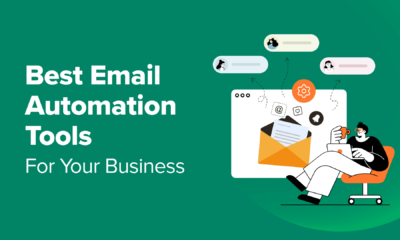MARKETING
The One Email KPI To Watch in the Age of Mail Privacy Protection
It’s been almost a year since Apple rolled out its Mail Privacy Protection (MPP) feature that effectively killed the open rate as an email marketing KPI.
While it wasn’t the “end of email,” some feared, it shook up how marketers test and optimize the success of their email campaigns.
In his presentations at Content Marketing World 2021, marketing strategist Michael Barber explained what Apple’s privacy protection feature does and the potential impact. At ContentTECH 2022, Michael updated the discussion with new insights on email engagement and a better email goal for marketers to focus on – driving replies.
Open and click-through rates don’t cut it anymore. In a world of increasing #privacy features, pick a metric that can survive: replies, says @joderama via @michaeljbarber @CMIContent. #Email #CMWorld #ContentTECH Click To Tweet
Did Apple cancel email marketing?
When marketers send an email to an Apple user, Apple ingests all the email’s images, links, and tracking information, encrypts it, and loads it remotely onto their servers. When it serves that email to the user, Apple counts it as an open – even if the intended recipient never opened it.
“We no longer get [data on] who opened an email, open times, geolocation (where someone is when they open that email), or the specific device that’s used,” Michael says.
This feature is available on all iOS15 devices (including iPads, iPhones, and Apple Watches). That encompasses 82% of all its mobile device users as of May 31, 2022. It’s also available on Macs with macOS Monterrey. It isn’t available for emails viewed through a third-party mail app (like Microsoft Outlook) or webmail.
Further, industry estimates say as many as 96% of iPhone and iPad users will turn on mail privacy protection. “This means we’ve lost access to [at least] 50% of the marketplace,” Michael says.
Even worse, he says other service providers have jumped on Apple’s email privacy bandwagon. For example, Google now blocks open-rate data for Gmail users as well as the millions who have emails from organizations running their email system on Google Workspace.
HANDPICKED RELATED CONTENT:
Forget opens – focus on trackable engagement metrics
Losing access to that open-rate data seems like grim news for marketers. Yet, Michael points out, other email metrics are more reliable – and accessible – indicators of engagement. That includes many of the campaign metrics marketers might receive from their email service providers (ESPs).
Email service providers no longer consider an open as a reliable signal of subscriber engagement, Michael says. Instead, they use engagement signals to measure the deliverability of your marketing campaigns, which helps determine their success.
Open rates are no longer considered a reliable signal of subscriber engagement. Deliverability is what matters now, says @michaeljbarber via @joderama @CMIContent. #Email #CMWorld #ContentTECH Click To Tweet
If your email subscribers aren’t sending strong signals that they’re engaged by your content, your campaigns might end up in the spam folder instead of the inbox, tanking your deliverability rates.
While opens play a small role in this equation, email service providers favor these signals:
- Messages moved to the junk folder or reported as spam
- Deleted messages
- Unsubscribes
- Addition of senders to address books
- Messages saved in a folder (both default folders and those the user creates)
- Messages moved out of a junk/spam folder
- Direct replies and responses to email messages/campaigns
The email service providers also rank those indicators by strength and as a positive or negative interaction, as illustrated in this Campaign Monitor graphic shared by Michael:

HANDPICKED RELATED CONTENT:
Make subscriber replies your priority KPI
Michael says email service providers see replies as the strongest positive signal of a recipient’s engagement with that sender’s content – and not just because Apple and Google don’t block your access to that data.
“As we think about getting emails in front of our subscribers, the question becomes, ‘How do we drive the action of [getting them to] reply,’” Michael says.
#Email service providers see replies as the strongest positive signal of a recipient’s engagement with that sender’s #content, says @michaeljbarber via @joderama @CMIContent. #CMWorld #ContentTECH Click To Tweet
He offered tips for reaching that goal:
Think conversations, not campaigns
Readers are more likely to respond to messages sent by a human, not a company. Prioritize plain, relatable language over jargon and marketing speak. Also, make sure to use a person’s name, not just the brand’s name, in the from line.
Michael shared an example from work management platform Asana. The company sends a series of welcome emails to onboard new customers. In all of them, the sender is identified as their account rep’s name (here, it’s Lauren Zoger).

HANDPICKED RELATED CONTENT:
Make it an obvious and easy action to take
Recipients may not realize they can reply directly to the email or believe anyone will read their feedback – unless you tell them. Your call to action is a great place to do that.
Place them in a prominent spot and create a URL with a mailto: link, so a click opens a new email in their window. You can include a thought-provoking question in the body copy of your campaign to let them know you’re interested in hearing what they have to say.
Writer Michael Estrin applies this approach skillfully in his weekly Situation Normal newsletters. His prompts are relevant to his story. Each is written to prompt an ongoing dialog. It’s a clever way to extend the audience’s engagement long after they’ve finished reading the content itself.

Get to the point
Your subscribers’ time is precious, and many only glance at your email in their inbox before deciding to open, ignore, or trash it.
Michael says a vague subject line wastes their time and won’t compel subscribers to engage with your campaign. Instead, use the space to say exactly what they’ll find and why it’s worth opening.
He points to email campaigns from sticker company Stickermule as an example of this best practice. The subject line – Last day for buttons – reveals exactly what the email is about (a product discount) and also emphasizes the time-sensitivity (last day for the deal):

Michael advises marketers to frontload the words that matter most in the subject line and use the pre-header or preview content to offer more context or details.
@Michaeljbarber advises marketers to frontload words that matter most in the #email subject line and use the pre-header or preview #content to offer more context via @joderama @CMIContent. #CMWorld #ContentTECH Click To Tweet
Make it a VIP-only affair
Emails with exclusive content and offers can help you achieve multiple content goals all at once, Michael says. That includes adding new subscribers, sustaining engagement of existing subscribers, and driving immediate replies and responses.
Travel discount service Scott’s Cheap Flights has built its brand on this approach. While anyone can visit Scott’s site for travel guides and stories, only newsletter subscribers are notified about the latest discount deals. The emails disclose the travel deal’s location and price range in the subject line.

To succeed with this technique, Michael recommends you share your most valuable content first with your email subscribers and wait as long as possible before you publish it on your open-access content platforms and channels.
Scott’s follows that advice too: It sends a special edition of the newsletter to its paid members whenever a really big discount comes along. They get first crack at the deal before it gets shared with other subscribers.
Understand the new rules of email engagement – and how to drive it
If your emails create satisfying experiences your subscribers want to read and respond to, you won’t have to worry about the effects of Apple’s privacy rules. By focusing on driving replies, you’ll have all the data needed to measure and optimize your email campaign success.
HANDPICKED RELATED CONTENT:
Cover image by Joseph Kalinowski/Content Marketing Institute



















You must be logged in to post a comment Login